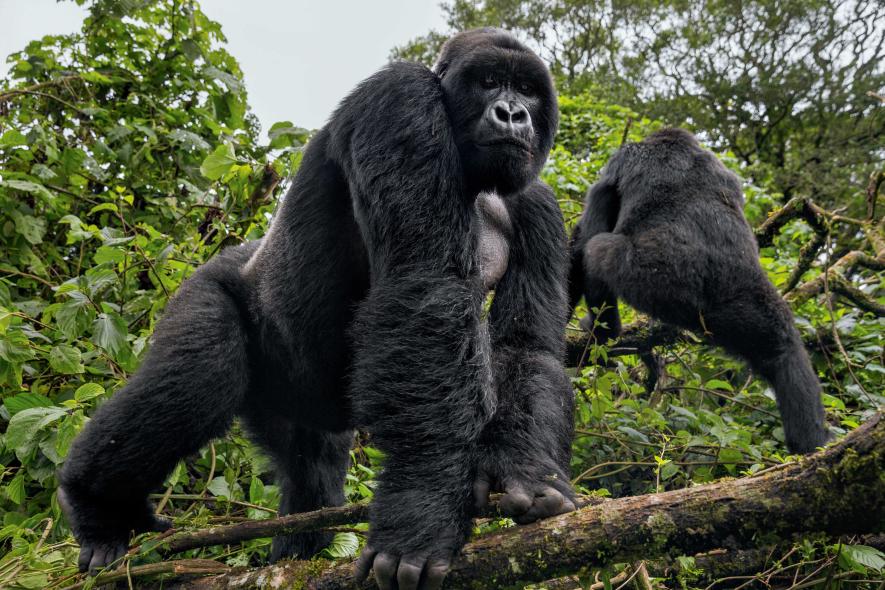Virunga National Park is one of the most special places on the planet. It is Africa’s oldest and most biologically diverse protected area. It’s home to more than 2,000 plant species, 706 bird species, and 218 mammal species. It is the only park in the world that harbors three species of great apes, including Chimpanzees, Lowland gorillas and Mountain Gorillas, and is home to more species of birds, reptiles and mammals than any other protected area on the continent.
Gorilla photography trips in Virunga National Park are very exciting because they do give you an opportunity to capture images of closest relatives to human beings while in the jungle. Mountain gorillas are close relatives to human beings hence attracting a lot of travelers.
In Virunga national park, there are 8 habituated mountain gorilla safaris that travelers on a gorilla photography safari can trek. Each of the gorilla families is trekked by a group of 8 people and also these must have gorilla trekking permits.
The gorilla trekking permits can be got in advance from Virunga National Park main website or a reputable tour operator. The photographing activity starts with a briefing at the park offices where all trekkers are taught about the rules and regulations of the trekking activity and even those of photography.
You will be led by armed ranger guides in the jungle and locating the mountain gorillas is 100% guaranteed because there are advance trackers that go to the jungle early to see where the mountain gorilla family is and then inform the rangers which route to use. The trekking activity takes 2-5 hours of meeting different park primates, mammals, and birds.
Once the mountain gorillas are located, the trekkers that want to take photographs must wait for the rangers to tell them if the gorillas are in good mood to be photographed. The photographers always hope to get the best images of the mountain gorillas during the gorilla safari. While photographing, the trekkers will see them eat, play, sleep and groom among others.
While on a gorilla photo safari, you need to inform the rangers to give you an exciting gorilla family to trek. Each habituated gorilla family in Volcanoes National Park has a different number of apes with some having more silver backs, infants, breastfeeding mothers, and much more. Trekking any of these mountain gorilla families gives a different experience, photographing can be easy, hectic, or frustrating depending on the gorilla family trekked as well as the location.
You should follow the instructions of the armed ranger guides when photographing mountain gorillas, they must know that these apes are very shy primates and so they should avoid looking directly in their eyes and use cameras that have no flashlight.
For better mountain gorilla images, photographers must use the right angles, take time to observe, and then capture the images. Mountain gorilla photography is done with cameras that have no flash because the apes can get irritated and charge sometimes.
If ready for Virunga National Park for gorilla photography, you are advised to bring lightweight cameras that have telephoto lens to help them capture images of gorillas even when they are far. The camera should have a lens that is 300mm to 400mm range in order to get the best shots. X-factor lenses are the best if your goal is to be the best photographer and share images online. Photographers who want to capture the facial expression of gorillas need to use burst mode which takes several shots at once.
Photographers need to take as many pictures as possible in the 1 hour given to be around the apes. Rules and regulations of the trekking activity must be followed especially keeping a distance of 7 meters even though you are photographing.
When you decide to go for gorilla photography in Virunga National Park, the dry season is the best time to follow. June to September and December to February are the best months to have gorilla photography safaris in Virunga National Park because they are characterized by little or no rainfall which leaves the vegetation dry and skies clear for photography. Here the vegetation is also short with clear views of the mountain gorillas. You will also have passable roads giving it an advantage to be the best season.
However, it can also be done in the rainy months of March to May and October to November and in these months, the photographers will be able to enjoy huge discounts on the accommodation as well as trekking permits. Though in this season, the vegetation is thick and photos are not clear as well as the rains spoiling the cameras.
When photographing mountain gorillas, look to photograph them in the shade. Typically, by the time you find the group it could be in the late morning or early afternoon and by this point the strong African sun is high in the sky and therefore too harsh for the optimal photographs.
Look for any members of the group that are fully in the shade where the light is consistent and there is little contrast. This will push your cameras a little harder as the light will be lower, but you will be left with even tones and beautiful fur detail rather than the strong light bouncing off the glossy coats.


